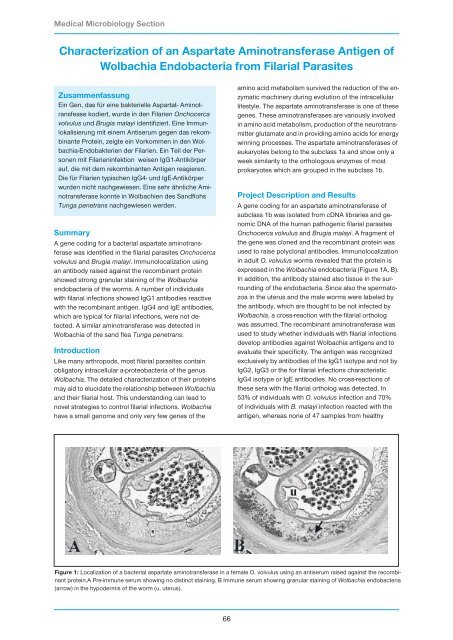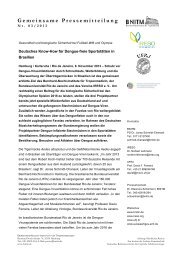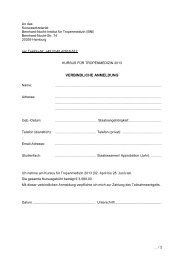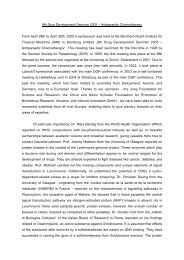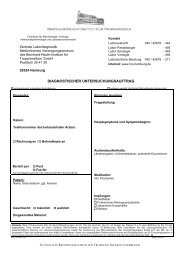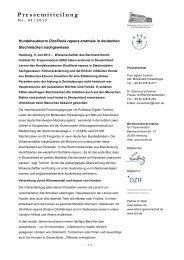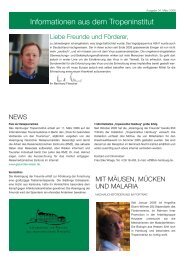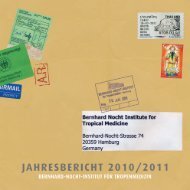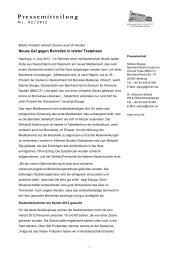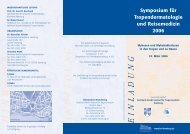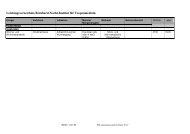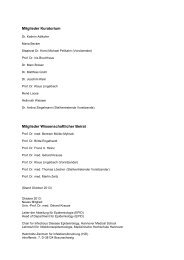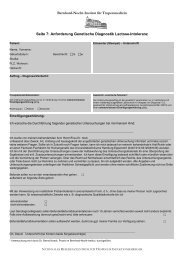Research Group Heussler (Malaria I) - Bernhard-Nocht-Institut für ...
Research Group Heussler (Malaria I) - Bernhard-Nocht-Institut für ...
Research Group Heussler (Malaria I) - Bernhard-Nocht-Institut für ...
You also want an ePaper? Increase the reach of your titles
YUMPU automatically turns print PDFs into web optimized ePapers that Google loves.
Medical Microbiology Section<br />
Characterization of an Aspartate Aminotransferase Antigen of<br />
Wolbachia Endobacteria from Filarial Parasites<br />
Zusammenfassung<br />
Ein Gen, das <strong>für</strong> eine bakterielle Aspartat- Aminotransfease<br />
kodiert, wurde in den Filarien Onchocerca<br />
volvulus und Brugia malayi identifiziert. Eine Immunlokalisierung<br />
mit einem Antiserum gegen das rekombinante<br />
Protein, zeigte ein Vorkommen in den Wolbachia-Endobakterien<br />
der Filarien. Ein Teil der Personen<br />
mit Filarieninfektion weisen IgG1-Antikörper<br />
auf, die mit dem rekombinanten Antigen reagieren.<br />
Die <strong>für</strong> Filarien typischen IgG4- und IgE-Antikörper<br />
wurden nicht nachgewiesen. Eine sehr ähnliche Aminotransferase<br />
konnte in Wolbachien des Sandflohs<br />
Tunga penetrans nachgewiesen werden.<br />
Summary<br />
A gene coding for a bacterial aspartate aminotransferase<br />
was identified in the filarial parasites Onchocerca<br />
volvulus and Brugia malayi. Immunolocalization using<br />
an antibody raised against the recombinant protein<br />
showed strong granular staining of the Wolbachia<br />
endobacteria of the worms. A number of individuals<br />
with filarial infections showed IgG1 antibodies reactive<br />
with the recombinant antigen. IgG4 and IgE antibodies,<br />
which are typical for filarial infections, were not detected.<br />
A similar aminotransferase was detected in<br />
Wolbachia of the sand flea Tunga penetrans.<br />
Introduction<br />
Like many arthropods, most filarial parasites contain<br />
obligatory intracellular a-proteobacteria of the genus<br />
Wolbachia.The detailed characterization of their proteins<br />
may aid to elucidate the relationship between Wolbachia<br />
and their filarial host. This understanding can lead to<br />
novel strategies to control filarial infections. Wolbachia<br />
have a small genome and only very few genes of the<br />
66<br />
amino acid metabolism survived the reduction of the enzymatic<br />
machinery during evolution of the intracellular<br />
lifestyle. The aspartate aminotransferase is one of these<br />
genes. These aminotransferases are variously involved<br />
in amino acid metabolism, production of the neurotransmitter<br />
glutamate and in providing amino acids for energy<br />
winning processes. The aspartate aminotransferases of<br />
eukaryotes belong to the subclass 1a and show only a<br />
week similarity to the orthologous enzymes of most<br />
prokaryotes which are grouped in the subclass 1b.<br />
Project Description and Results<br />
A gene coding for an aspartate aminotransferase of<br />
subclass 1b was isolated from cDNA libraries and genomic<br />
DNA of the human pathogenic filarial parasites<br />
Onchocerca volvulus and Brugia malayi. A fragment of<br />
the gene was cloned and the recombinant protein was<br />
used to raise polyclonal antibodies. Immunolocalization<br />
in adult O. volvulus worms revealed that the protein is<br />
expressed in the Wolbachia endobacteria (Figure 1A, B).<br />
In addition, the antibody stained also tissue in the surrounding<br />
of the endobacteria. Since also the spermatozoa<br />
in the uterus and the male worms were labeled by<br />
the antibody, which are thought to be not infected by<br />
Wolbachia, a cross-reaction with the filarial ortholog<br />
was assumed. The recombinant aminotransferase was<br />
used to study whether individuals with filarial infections<br />
develop antibodies against Wolbachia antigens and to<br />
evaluate their specificity. The antigen was recognized<br />
exclusively by antibodies of the IgG1 isotype and not by<br />
IgG2, IgG3 or the for filarial infections characteristic<br />
IgG4 isotype or IgE antibodies. No cross-reactions of<br />
these sera with the filarial ortholog was detected. In<br />
53% of individuals with O. volvulus infection and 70%<br />
of individuals with B. malayi infection reacted with the<br />
antigen, whereas none of 47 samples from healthy<br />
Figure 1: Localization of a bacterial aspartate aminotransferase in a female O. volvulus using an antiserum raised against the recombinant<br />
protein.A Pre-immune serum showing no distinct staining. B Immune serum showing granular staining of Wolbachia endobacteria<br />
(arrow) in the hypodermis of the worm (u, uterus).


